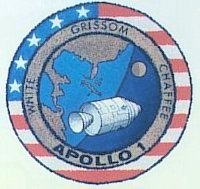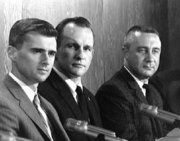Apollo 1
|
|
| Mission Insignia | |
|---|---|

| |
| Planned Mission | |
| Mission Name: | Apollo 1 (AS-204) |
| Call Sign: | Command module: Apollo 1 |
| Number of Crew: | 3 |
| Planned Launch: | February 21, 1967 Kennedy Space Center LC 34 |
| Planned Apogee: | ~300 km |
| Planned Perigee: | ~230 km |
| Planned Period: | ~89.7 m |
| Planned Inclination: | ~31° |
| Planned Landing: | March 7, 1967 Atlantic Ocean N of Puerto Rico planned carrier USS Essex (CV-9) |
| Planned Duration: | 14 days |
| Planned Number of Orbits: | ~200 |
| Mass: | CSM 20,412 kg |
| Crew Picture | |
| Missing image GPN-2000-000618.jpg Apollo 1 crew portrait (L-R: Grissom, White and Chaffee) Apollo 1 crew portrait (L-R: Grissom, White and Chaffee) | |
| Apollo 1 Crew | |
Apollo One is the name given to the Apollo/Saturn 204 (AS-204) spacecraft after it was destroyed by fire during a training exercise on January 27, 1967, at Pad 34 atop a Saturn IB rocket. Its crew were the astronauts selected for the initial Apollo program mission: Command Pilot Virgil I. Grissom, Senior Pilot Ed White, and Pilot Roger B. Chaffee.
| Contents [hide] |
Crew
- Virgil Grissom (flew on Mercury 4 & Gemini 3), Command Pilot
- Edward White (flew on Gemini 4), Senior Pilot
- Roger Chaffee (never flew in space), Pilot
Backup Crew
- April - December, 1966
- James McDivitt, Command Pilot
- David Scott, Senior Pilot
- Rusty Schweickart, Pilot
This crew became the crew of Apollo 9.
- December, 1966 - January, 1967
- Walter Schirra, Command Pilot
- Donn Eisele, Senior Pilot
- Walter Cunningham, Pilot
This crew became the crew of Apollo 7.
The accident
Apollo_1_fire.jpg
Immediately prior to the accident, the crew were reclining in their horizontal couches, running through a checklist of things they would do in space while a communication system problem was being fixed. Suddenly, a voice (now believed to be Chaffee's, as his was the only clear channel) crackled over the COM link, "Fire, I smell fire." The transmission ended with a cry of pain. The crew could not escape because the hatch opened inward, requiring that the cabin be depressurized. At best, the hatch would have taken 90 seconds to open, while the crew were killed in only about 15 seconds.
Cause
The fire is believed to have been caused by a spark somewhere in 30 miles (50 km) of wiring, leading to rapid combustion in the pressurized oxygen atmosphere. The Apollo 204 Review Board determined that a silver-plated copper wire running through an environmental control unit near the command module pilot's couch had become stripped of its insulation and abraded by repeated opening and closing of an associated access door. This weak point in the wiring also happened to pass near a junction in a ethylene glycol / water cooling line, which had developed a leak. The electrolysis of ethylene glycol solution with the anode made of silver resulted in a violent exothermic reaction that ignited the ethylene glycol mixture, which in turn was able to burn in the atmosphere of pure pressurized oxygen.[1] (http://www.hq.nasa.gov/office/pao/History/SP-4009/v4p2b.htm)
The fire
The fire spread quickly, melting through the astronauts' space suits. Grissom's and White's suits were later found to have fused together. It was confirmed that the crew had died of smoke inhalation rather than burns. According to the Report of the Apollo 204 Review Board - Appendix D Panel 11 (link provided below); Grissom suffered third degree burns on 36% of his body (1st, 2nd and 3rd degree burns covered 60% of his body) and his spacesuit was 70% destroyed. White suffered third degree burns on 40% of his body (1st, 2nd and 3rd degree burns covered 48% of his body) and his spacesuit was 25% destroyed. Chaffee suffered third degree burns on 23% of his body (1st, 2nd and 3rd degree burns covered 29% of his body) and his spacesuit was 15% destroyed.
The company that produced the command module, North American Aviation, had originally suggested that the hatch open outward and be able to open with explosive bolts in case of emergency. They had also suggested that the atmosphere be an oxygen/nitrogen mixture, like the air around us. NASA didn't agree, arguing that the hatch could be accidentally opened, and that if too much nitrogen were released into the atmosphere, the astronauts would pass out and then die. They also argued that since a pure oxygen atmosphere was used safely in Mercury and Gemini, it should be safe to use for Apollo. After the fire, Apollo was grounded pending a redesign, with the following results:
- The atmosphere would not be pressurized to two lb/in² (14 kPa) above atmospheric pressure
- The hatch would open outward, and more quickly
- Flammable materials were replaced with self extinguishing materials
- Plumbing and wiring were covered with protective insulation
- 1,407 wiring problems were corrected
- Nylon suits were replaced with coated glass fabric suits
When North American Aviation shipped Spacecraft CM-012 to Kennedy Space Center, it bore a banner proclaiming it "Apollo One" and Grissom's crew had received approval for an "Apollo 1" patch in June 1966, but NASA was planning to call that mission "AS-204." After the fire, the astronauts' widows asked that "Apollo 1" be reserved for the flight their husbands would never make. For a time, mission planners called the next scheduled launch "Apollo 2." Suggestions were made that the flights should be called "Apollo 1" (AS-204), "Apollo 1A" (AS-201), "Apollo 2" (AS-202), and "Apollo 3" (AS-203). Finally, the NASA Project Designation Committee approved "Apollo 4" for the first (unmanned) Apollo-Saturn V mission (AS-501), but declared that there would be no retroactive renaming of AS-201, -202, or -203. The Apollo 1 (AS-204) Saturn IB rocket was taken down from Launch Complex 34 and later reassembled at Launch Complex 37B. It was used to launch the Apollo 5 LM-1 into earth orbit for the first Lunar Module test mission.
Then-Senator Walter Mondale headed a commission to investigate the fire. The investigation was seen by some as a witch hunt by Mondale to further his aim of diverting funds from NASA into social programs.
Memorial
Apollo_1_plaque.png
The site of the fire now bears two plaques for the 3 men who perished. One says:
LAUNCH COMPLEX 34
Friday, 27 January 1967
1831 Hours
Dedicated to the living memory of the crew of the Apollo 1:
U.S.A.F. Lt. Colonel Virgil I. Grissom
U.S.A.F. Lt. Colonel Edward H. White, II
U.S.N. Lt. Commander Roger B. Chaffee
They gave their lives in service to their country in the ongoing exploration of humankind's final frontier. Remember them not for how they died but for those ideals for which they lived.
Apollo_1_2nd_plaque.png
The other says:
IN MEMORY OF THOSE WHO MADE THE ULTIMATE SACRIFICE SO OTHERS COULD REACH FOR THE STARS
AD ASTRA PER ASPERA
(A ROUGH ROAD LEADS TO THE STARS)
GOD SPEED TO THE CREW OF APOLLO 1
This plaque was featured in the film Armageddon.
Controversy
The USENET newsgroups sci.space.history and sci.space.policy frequently see semi-anonymous postings, which accuse NASA and / or other US authorities of arson and conspiring to assassinate the crew of Apollo 1. It is often claimed NASA people held Grissom personally responsible for the loss of the Liberty Bell 7 capsule to sea and wanted to avenge this agency-wide loss of face. According to the Star tabloid, Grissom's son Scott Grissom, a pilot himself, demanded a renewed investigation into the Apollo-1 disaster back in 1999. Nonetheless, the above said newsgroup postings are generally considered as trolling by the USENET community.
The "Apollo 1" website [2] (http://www.apollo1.info) which is owned by Scott Grissom, explicitly prosecutes the thesis that the Apollo 1 astronauts "died from an act of sabotage".
See also
External links
- NASA Apollo 1 website (http://www.hq.nasa.gov/office/pao/History/Apollo204/)
- Apollo spacecraft 012 (Apollo 1) Operations Handbook (PDF) (http://ntrs.nasa.gov/archive/nasa/casi.ntrs.nasa.gov/19730061045_1973061045.pdf)
- Report of the Apollo 204 (Apollo 1) Accident Review Board (PDF) (http://ntrs.nasa.gov/archive/nasa/casi.ntrs.nasa.gov/19820066930_1982066930.pdf)
- Report of the Apollo 204 (Apollo 1) Accident Review Board - Appendix A: (PDF) (http://ntrs.nasa.gov/archive/nasa/casi.ntrs.nasa.gov/19820066928_1982066928.pdf)
- Report of the Apollo 204 (Apollo 1) Accident Review Board - Appendix B: (PDF) (http://ntrs.nasa.gov/archive/nasa/casi.ntrs.nasa.gov/19820066927_1982066927.pdf)
- Report of the Apollo 204 (Apollo 1) Accident Review Board - Appendix C Section 1: (PDF) (http://ntrs.nasa.gov/archive/nasa/casi.ntrs.nasa.gov/19820066925_1982066925.pdf)
- Report of the Apollo 204 (Apollo 1) Accident Review Board - Appendix C Section 2: (PDF) (http://ntrs.nasa.gov/archive/nasa/casi.ntrs.nasa.gov/19820066936_1982066936.pdf)
- Report of the Apollo 204 (Apollo 1) Accident Review Board - Appendix D Panels 1 thru 4: (PDF) (http://ntrs.nasa.gov/archive/nasa/casi.ntrs.nasa.gov/19820066931_1982066931.pdf)
- Report of the Apollo 204 (Apollo 1) Accident Review Board - Appendix D Panel 5: (PDF) (http://ntrs.nasa.gov/archive/nasa/casi.ntrs.nasa.gov/19820066926_1982066926.pdf)
- Report of the Apollo 204 (Apollo 1) Accident Review Board - Appendix D Panels 6 thru 10: (PDF) (http://ntrs.nasa.gov/archive/nasa/casi.ntrs.nasa.gov/19820066932_1982066932.pdf)
- Report of the Apollo 204 (Apollo 1) Accident Review Board - Appendix D Panel 11: (PDF) (http://ntrs.nasa.gov/archive/nasa/casi.ntrs.nasa.gov/19820066929_1982066929.pdf)
- Report of the Apollo 204 (Apollo 1) Accident Review Board - Appendix D Panels 12 thru 17: (PDF) (http://ntrs.nasa.gov/archive/nasa/casi.ntrs.nasa.gov/19820066933_1982066933.pdf)
- Report of the Apollo 204 (Apollo 1) Accident Review Board - Appendix D Panel 18: (PDF) (http://ntrs.nasa.gov/archive/nasa/casi.ntrs.nasa.gov/19820066923_1982066923.pdf)
- Report of the Apollo 204 (Apollo 1) Accident Review Board - Appendix D Panels 19 thru 21: (PDF) (http://ntrs.nasa.gov/archive/nasa/casi.ntrs.nasa.gov/19820066934_1982066934.pdf)
- Report of the Apollo 204 (Apollo 1) Accident Review Board - Appendix E: (PDF) (http://ntrs.nasa.gov/archive/nasa/casi.ntrs.nasa.gov/19820066935_1982066935.pdf)
- Report of the Apollo 204 (Apollo 1) Accident Review Board - Appendix F: (PDF) (http://ntrs.nasa.gov/archive/nasa/casi.ntrs.nasa.gov/19820066537_1982066537.pdf)
- Report of the Apollo 204 (Apollo 1) Accident Review Board - Appendix G: (PDF) (http://ntrs.nasa.gov/archive/nasa/casi.ntrs.nasa.gov/19820067189_1982067189.pdf)
Template:Project Apollode:Apollo 1 fr:Apollo 1 it:Apollo 1 he:אפולו 1 ja:アポロ1号 hu:Apollo-1 pl:Apollo 1 fi:Apollo 1

